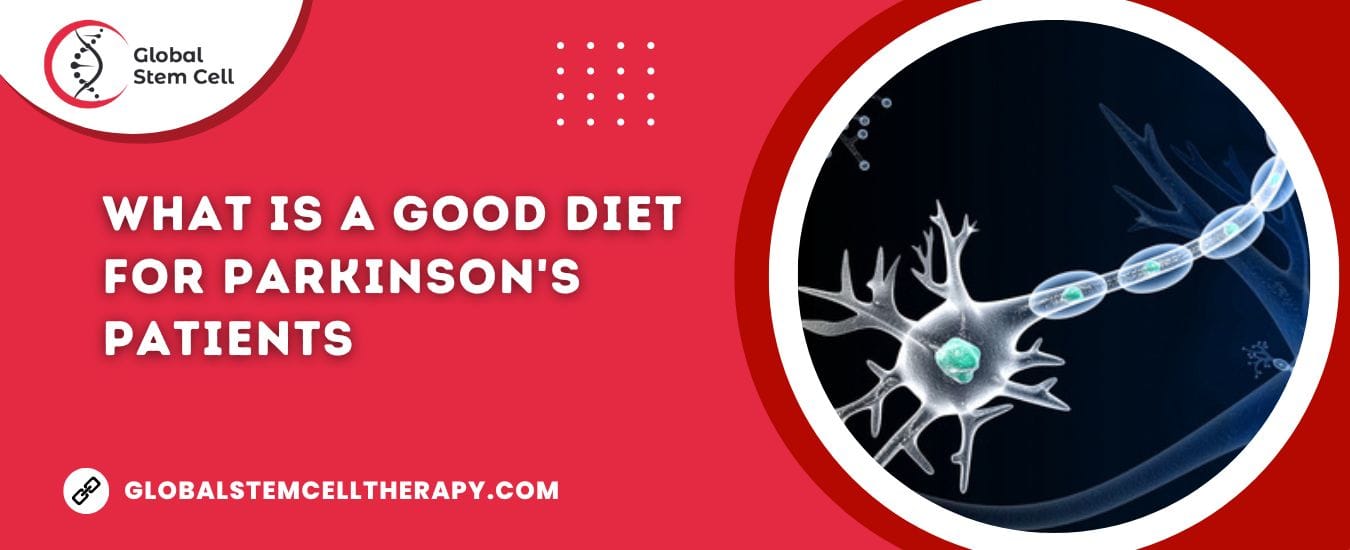A Comprehensive Guide to What is a Good Diet for Parkinson’s Patients?
Table of Content
What is a Good Diet for Parkinson’s Patients? is a question that patients, caregivers, and healthcare providers grapple with as they navigate the landscape of this neurodegenerative disorder. In an age where healthcare is perpetually evolving, food and health science have revealed their symbiotic relationship to us in remarkable ways.
Each bite we take not only satiates our cravings but has the potential to enhance our overall well-being. The complex interplay of nutrients can have profound effects on our bodies, helping to fortify our defenses, boost our energy levels, and maintain our health. Particularly for those living with chronic conditions like Parkinson’s disease, the power of a nutrient-dense diet cannot be overstated.
Nutrition plays a critical role in the management of Parkinson’s disease. As the disease progresses, symptoms like difficulty swallowing and slower digestion can make eating certain foods challenging. Coupled with medication side-effects like reduced appetite and nausea, the nutritional status of individuals with Parkinson’s can be severely affected. However, with careful planning and the right dietary strategies, these challenges can be managed effectively.
Navigating the maze of nutrition can often be confusing, especially with an overload of information available at our fingertips. But fear not. Our journey into the world of Parkinson’s and nutrition is designed to simplify the complex, making the art of healthy eating an enjoyable and achievable part of your daily routine.
Intrigued? Buckle up and join us as we embark on a culinary journey towards better health, exploring the best foods to fight Parkinson’s, foods to avoid, the secret of protein timing, and much more. Together, let’s savor the power of nutrition and its potential to transform lives, one meal at a time.
Understanding Parkinson’s Disease
Named after Dr. James Parkinson, who first described the condition in 1817, Parkinson’s disease (PD) is a neurodegenerative disorder that primarily affects the area of the brain called the substantia nigra. This area is rich in dopamine-producing neurons, which are essential for smooth and controlled muscle movements.
Over time, these dopamine-producing cells progressively deteriorate, leading to a shortage of dopamine, a neurotransmitter that is critical for coordinating smooth and controlled movements. The result is the range of motor symptoms characteristic of Parkinson’s disease.
The progression of Parkinson’s disease is typically slow and insidious, taking several years to manifest noticeable symptoms. It is estimated that by the time the classic motor symptoms like tremors, stiffness, and slow movements are observed, a significant portion of dopamine neurons may have already been lost.
Symptoms and Challenges
The onset of Parkinson’s disease is often marked by motor symptoms, which can vary from person to person. The most recognizable symptom is a resting tremor, which typically affects one side of the body initially, particularly the hands or fingers. Other common motor symptoms include bradykinesia (slowness of movement), limb rigidity, and balance problems.
However, Parkinson’s disease is not just a movement disorder. It also presents several non-motor symptoms, often overlooked but significantly impacting the quality of life. These include mood changes, sleep disorders, cognitive changes, constipation, and difficulties with swallowing.
Living with Parkinson’s disease presents several unique challenges. Everyday tasks that we often take for granted, such as eating, drinking, and even speaking, can become significant hurdles. Swallowing difficulties and slower gastric emptying can impact a person’s ability to consume and digest food properly. Moreover, certain medications used to manage Parkinson’s symptoms can have side effects like nausea, reduced appetite, and dry mouth, all of which can adversely impact nutritional intake.
The Ideal Diet for Parkinson’s Patients
The answer to the Question about What is a Good Diet for Parkinson’s Patients? is here! Now lets dive in to learn about What is a Good Diet for Parkinson’s Patients:
Creating an ideal diet for Parkinson’s patients involves much more than merely choosing healthy foods. It requires a nuanced understanding of the disease’s effects on the body, the interactions between certain foods and medications, and the specific nutritional needs of individuals living with Parkinson’s. The following sections delve into these complexities in greater detail.
Antioxidant-Rich Foods
In the context of Parkinson’s disease, oxidative stress is a key player. This term refers to an imbalance between free radicals (harmful compounds that can damage cells) and the body’s ability to counteract their harmful effects. Foods rich in antioxidants help to restore this balance by neutralizing free radicals, potentially slowing the disease’s progression.
To bolster your antioxidant intake, focus on foods like:
- Fruits: Berries, such as strawberries, raspberries, and blueberries, are particularly high in antioxidants. Other fruits like oranges, kiwis, and pomegranates also offer substantial antioxidant content.
- Vegetables: Spinach, kale, bell peppers, and beets are excellent sources.
- Nuts and Seeds: Almonds, walnuts, and flaxseeds are high in vitamin E, a powerful antioxidant.
- Fish and Lean Meats: These can provide selenium, another antioxidant.
High-Fiber Foods
One common non-motor symptom of Parkinson’s is constipation, often resulting from the slower movement of the digestive system. A high-fiber diet can help by adding bulk to stool, thus aiding regular bowel movements. Here are some fiber-rich choices:
- Whole Grains: Foods like brown rice, oatmeal, and whole-grain bread or pasta are excellent sources of fiber.
- Fruits and Vegetables: These are always a good idea. Specifically, bananas, apples, oranges, strawberries, and raspberries are fiber-rich fruits, while vegetables like carrots, beets, broccoli, and Brussels sprouts also provide a good amount of fiber.
- Legumes: Beans, lentils, and peas are extremely high in fiber.
Healthy Fats
The brain is a fat-rich organ, and healthy fats, particularly omega-3 fatty acids, are essential for its proper functioning. They also have anti-inflammatory properties, which could be beneficial in the context of neurodegenerative disorders.
- Fatty Fish: Salmon, mackerel, tuna, and sardines are high in omega-3s.
- Seeds and Nuts: Flaxseeds, chia seeds, walnuts, and hemp seeds are all excellent plant-based sources of omega-3s.
Lean Proteins
Proteins play a vital role in building and repairing body tissues, including muscles, and they provide a source of energy. However, they need to be balanced with Parkinson’s medications, particularly levodopa, because they compete for absorption in the small intestine.
When incorporating protein into your diet, consider:
- Timing: Try to consume most of your protein in the evening, which can allow your medication to be more effective during the day.
- Sources: Opt for lean sources of protein such as poultry, fish, legumes, and tofu to avoid consuming excessive unhealthy fats.
This “ideal diet” is not one-size-fits-all. It should be tailored to fit individual nutritional needs, medication schedules, and lifestyle habits. Consultation with a dietitian or healthcare provider is crucial to develop a personalized diet plan for Parkinson’s disease.
Foods to Avoid
While a balanced diet encourages a wide variety of foods, certain items should be limited or avoided in a Parkinson’s-friendly diet due to their potential to worsen symptoms or interact negatively with medications.
- High Sodium Foods: Processed foods, canned goods, and certain restaurant meals can be high in sodium, which may increase blood pressure and contribute to other health complications.
- Sugary Foods and Drinks: These can lead to rapid fluctuations in blood sugar levels and contribute to weight gain and other health problems.
- Certain Proteins: As mentioned, high protein foods can interfere with the absorption of Parkinson’s medications, particularly levodopa. It’s not about completely avoiding protein but timing its consumption appropriately.
The ideal diet for Parkinson’s patients might look slightly different for each person, as individual nutritional needs, preferences, and tolerances can vary greatly. It’s crucial to remember that there is no one-size-fits-all diet, and modifications may be necessary to suit individual needs and lifestyle. With the help of healthcare professionals and dietitians, you can navigate the journey to optimal nutrition for Parkinson’s disease.
The Vital Role of Diet in Parkinson’s Disease
A balanced diet is the cornerstone of health, acting as the body’s primary source of energy, nutrients, and the raw materials needed for growth, repair, and maintenance of normal body functions. In the context of Parkinson’s disease, diet takes on an even greater significance.
Nutrition directly impacts both the body’s general health and the specific symptoms associated with Parkinson’s. Nutrient-dense foods can provide the energy needed to cope with the physical changes brought on by the disease, and certain nutrients may even contribute to managing specific symptoms.
For instance, a diet high in fiber can help alleviate constipation, a common problem in Parkinson’s disease. Consuming adequate fluids can help maintain proper hydration and promote better digestion, which can be a challenge for individuals with PD.
The Parkinson’s Disease-Food Connection
Emerging research suggests that certain foods and nutrients may have neuroprotective properties that could potentially slow down the progression of Parkinson’s disease. For instance, foods rich in antioxidants may help neutralize harmful free radicals, reducing oxidative stress, which is believed to play a significant role in the pathogenesis of PD.
Omega-3 fatty acids found in fatty fish and flaxseeds have been associated with improved brain health, and some research suggests they might be beneficial for neurodegenerative conditions like PD.
Equally important is understanding the impact of certain foods and dietary components on the effectiveness of Parkinson’s medications. For instance, levodopa, one of the primary medications used to treat PD symptoms, can compete with dietary proteins for absorption in the small intestine. Therefore, timing protein intake around medication schedules can optimize the effectiveness of this drug.
Indeed, the power of nutrition in managing Parkinson’s disease is a dynamic and promising field. By marrying ongoing research with individual dietary choices, we have the potential to make every meal an opportunity for improved health and well-being.
Deconstructing the Parkinson’s Diet
Dietary management of Parkinson’s disease goes beyond the simple maxim of “eat healthily”. It involves understanding the effects of specific dietary components and adapting eating patterns to work in synergy with medication regimens. Let’s break down the key elements of the Parkinson’s diet.
Aiming for Antioxidants
Antioxidants are a group of compounds that neutralize harmful free radicals in our bodies, reducing oxidative stress. Oxidative stress is believed to be a significant player in the development of Parkinson’s disease. Foods rich in antioxidants include brightly colored fruits and vegetables, nuts, seeds, and certain types of fish and meats. Green tea and dark chocolate are also rich sources of antioxidants. By including these foods in your diet, you can boost your antioxidant intake and potentially slow the progression of Parkinson’s disease.
Befriending Fiber
Fiber plays a crucial role in promoting healthy digestion and preventing constipation, a common non-motor symptom of Parkinson’s. The average adult should aim for at least 25-30 grams of fiber per day, sourced from whole grains, fruits, vegetables, and legumes. Remember to introduce fiber gradually into your diet and increase water intake simultaneously to prevent gas and bloating.
Protein Timing: The Secret Key
One of the most challenging aspects of a Parkinson’s diet is managing protein intake. While essential for health, protein can interfere with the absorption of levodopa, a common medication used in Parkinson’s disease. The key is to time your protein consumption correctly, typically consuming most of your protein in the evening, allowing your medication to be more effective during the day.
Hydration
Adequate hydration is essential for everyone but particularly for people with Parkinson’s disease. It aids digestion, helps prevent constipation, and supports overall bodily functions. It’s crucial to consume enough fluids throughout the day, whether it’s in the form of water, herbal teas, or water-rich foods like cucumbers and melons.
By understanding these elements, you can create a dietary plan that not only nourishes your body but also specifically supports your battle against Parkinson’s disease. It’s about turning your meals into powerful tools for health and wellness. Remember, it’s always recommended to consult with a healthcare professional or dietitian to tailor your dietary plan to your specific needs and medication regimen.
Adapting Your Diet to Parkinson’s Symptoms
Parkinson’s disease brings with it a unique set of challenges that can impact a person’s ability to consume and digest food effectively. Fortunately, by modifying our dietary habits and meal structure, we can adapt to these changes and ensure that our bodies are well-nourished and energized.
Managing Swallowing Difficulties
Dysphagia, or difficulty swallowing, is a common issue for those with Parkinson’s disease. This can make meal times challenging and potentially dangerous due to the risk of choking or aspiration. To manage this:
Opt for softer foods that are easier to swallow, such as mashed potatoes, pureed fruits, smoothies, and soups.
Chew your food thoroughly before swallowing. This can aid in digestion and reduce the risk of choking.
Stay upright during and after meals. Gravity can help move food from the mouth to the stomach.
Combatting Constipation
Constipation is a common non-motor symptom of Parkinson’s disease. Not only is it uncomfortable, but it can also lead to other health complications if not managed effectively. Here are some dietary strategies to combat constipation:
Increase your fiber intake: Fiber adds bulk to your stool, making it easier to pass. Incorporate more whole grains, fruits, vegetables, and legumes into your meals.
Stay hydrated: Water helps soften your stool, making it easier to pass. Aim for at least 8 glasses of water a day, unless advised otherwise by your doctor.
Regular physical activity: Physical activity can stimulate bowel movement and aid in regularity.
Remember, every individual with Parkinson’s disease is unique, and what works for one may not work for another. It’s important to work with a healthcare professional to tailor these strategies to your specific needs and symptoms. Despite these challenges, remember that a healthy, enjoyable diet is still within reach. By adapting your diet to your symptoms, you’re taking a proactive step towards better health and quality of life.
Supplements and Medication
In addition to a balanced diet, supplements and medication can also play a vital role in managing Parkinson’s disease. They can fill nutritional gaps, combat symptoms, and even work to slow disease progression. However, they must be used judiciously and under the guidance of a healthcare professional.
Nutritional Supplements
There are several nutritional supplements that may be beneficial for people with Parkinson’s disease, either to manage symptoms or to meet nutritional needs.
- Fiber Supplements: For those struggling with constipation, fiber supplements can be a useful addition to a high-fiber diet.
- Vitamin D and Calcium: These are important for bone health, which can be compromised in Parkinson’s disease due to mobility issues and certain medications.
- B Vitamins: B vitamins, particularly B6, B9, and B12, are crucial for brain health. They may be particularly beneficial for those with elevated homocysteine levels, a common occurrence in those taking levodopa.
- Coenzyme Q10: This antioxidant has been studied for its potential neuroprotective effects, though more research is needed.
Remember that while supplements can be beneficial, they are not a substitute for a balanced diet. It’s always best to get nutrients from food first.
Medication Management
Medication plays a crucial role in managing Parkinson’s disease. One of the most common medications used is levodopa, which replaces the dopamine that the brain can no longer make. However, it can interact with dietary protein, as they both use the same transport system in the gut and blood-brain barrier. Thus, a person may need to adjust the timing of their protein intake to ensure that they are getting the most from their medication.
Other Parkinson’s medications, such as dopamine agonists, MAO-B inhibitors, and COMT inhibitors, have their own dietary considerations and potential side effects. Therefore, it’s important to work with a healthcare professional to understand these interactions and develop a dietary and medication plan that works best for you.
In the fight against Parkinson’s disease, supplements and medication are powerful tools. When used correctly and in combination with a balanced diet, they can significantly improve the quality of life and health outcomes for those living with Parkinson’s disease.
Final Note
Navigating these dietary considerations might seem daunting, but remember, you are not alone in this journey. With the guidance of healthcare professionals and the support of loved ones, adapting your diet to Parkinson’s disease is not only achievable but can also be an empowering step towards embracing a healthier future. By harnessing the power of nutrition, we can create a supportive environment for our bodies, paving the way for better health outcomes and a higher quality of life, even in the face of Parkinson’s disease.
Every meal is an opportunity to nourish your body, manage symptoms, and enjoy the simple pleasures of good food. So here’s to seizing those opportunities, one bite at a time.







